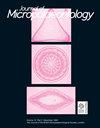在一粒沙子上——来自始新世早期北冰洋的机会性凝集有孔虫半孔虫的微栖息地
IF 1.8
3区 地球科学
Q1 PALEONTOLOGY
引用次数: 2
摘要
摘要半球形有孔虫是在始新世早期北冰洋陆架沉积物中发现的一种附着的单thalamous凝集有孔虫。它是在古新世-始新世热极大期引起的微动物更替之后,在北冰洋上分布的地方性凝集有孔虫组合的一个简单而独特的组成部分。伴生有孔虫的特点是单thalamous物种的比例很高(高达60% %),并且完全凝集,表明早始新世的咸淡(中盐)北冰洋。apta是一种附着在沉积物中细小碎屑颗粒(0.2 ~ 1.8 mm)上的单株。它是一个小物种(直径0.06至0.2 毫米),细粒,低半球形轮廓,附着区域没有地板,没有实质性的边缘法兰,没有内部结构,没有孔径。由于没有孔,它显然是通过试验壁上微小(微米大小)的间隙孔传播和喂养的。连接表面从凹到凸,从粗糙到光滑。附着物颗粒的形状和类型各不相同,但主要是石英和燧石。始新世早期猿人的存在是对活跃水文系统(风暴事件)环境的机会性反应。附着在沙粒上可以在被风暴产生的洋流筛过的海床上提供一个更稳定的基地。有孔虫与原位物种混合的相对丰度表明了主动运输。与被改造过的白垩纪有孔虫标本的附着表明,猿足猿曾在同一时期进行过改造和定植。本文章由计算机程序翻译,如有差异,请以英文原文为准。
On a grain of sand – a microhabitat for the opportunistic agglutinated foraminifera Hemisphaerammina apta n. sp., from the early Eocene Arctic Ocean
Abstract. Hemisphaerammina apta n. sp. is an attached monothalamous agglutinated foraminifera discovered in shelf sediments of the early Eocene Arctic Ocean. It is a simple yet distinctive component of the endemic agglutinated foraminiferal assemblage that colonized the Arctic Ocean after the microfaunal turnover caused by the Paleocene–Eocene Thermal Maximum. Associated foraminifera are characterized by a high percentage of monothalamous species (up to 60 %) and are entirely agglutinated indicating a brackish (mesohaline) early Eocene Arctic Ocean. Hemisphaerammina apta occurs exclusively as individuals attached to fine detrital grains (0.2 to 1.8 mm) of sediment. It is a small species (0.06 to 0.2 mm in diameter), fine-grained, with a low hemispherical profile, no floor across the attachment area, no substantive marginal flange, no internal structures, and no aperture. Lacking an aperture, it apparently propagated and fed through minute (micrometre-sized) interstitial pores in the test wall. Attachment surfaces vary from concave to convex and rough to smooth. Grains for attachment are diverse in shape and type but are predominantly of quartz and chert. The presence of H. apta in the early Eocene was an opportunistic response to an environment with an active hydrological system (storm events). Attachment to grains of sand would provide a more stable base on a sea floor winnowed by storm-generated currents. Active transport is indicated by the relative abundance of reworked foraminifera mixed with in situ species. Contemporaneous reworking and colonization by H. apta is suggested by its attachment to a reworked specimen of Cretaceous foraminifera.
求助全文
通过发布文献求助,成功后即可免费获取论文全文。
去求助
来源期刊

Journal of Micropalaeontology
生物-古生物学
CiteScore
4.30
自引率
5.00%
发文量
7
审稿时长
>12 weeks
期刊介绍:
The Journal of Micropalaeontology (JM) is an established international journal covering all aspects of microfossils and their application to both applied studies and basic research. In particular we welcome submissions relating to microfossils and their application to palaeoceanography, palaeoclimatology, palaeobiology, evolution, taxonomy, environmental change and molecular phylogeny.
 求助内容:
求助内容: 应助结果提醒方式:
应助结果提醒方式:


